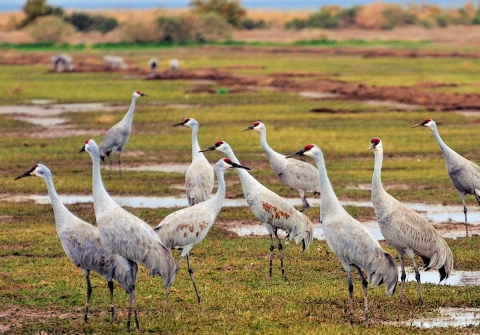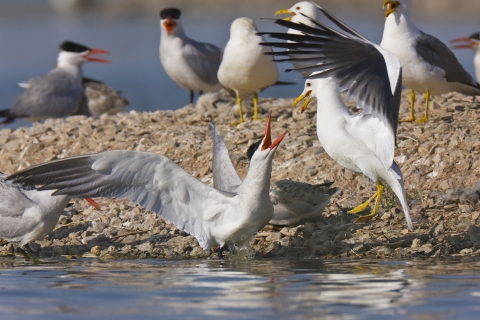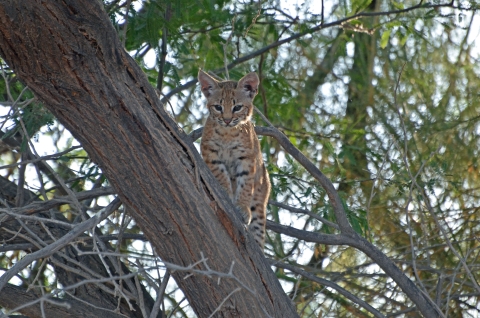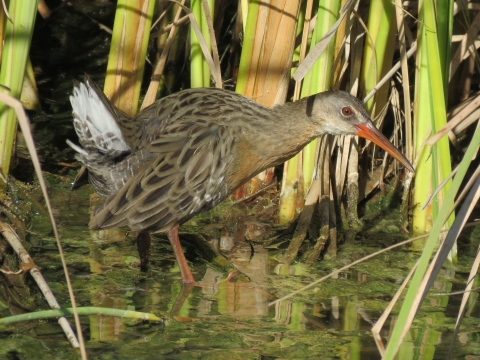Seasons of Wildlife
There’s always something to see at the Sea! Some birds spend the winter at the Sonny Bono Salton Sea National Wildlife Refuge; others use it as a “rest stop” during spring and fall migration; still, others find a year-round home here.
Spring
In spring, overwintering species such as the snow & Ross geese, ducks, and shorebirds--are leaving the refuge wetlands and starting to head north to their summer nesting sites. Meanwhile, migratory birds that wintered further south, including wood warblers and red-winged blackbirds, are touching down at the refuge to rest and feed before continuing to their breeding grounds further north. American kestrels, Northern harriers, burrowing owls, and other resident raptors are courting mates and preparing to nest.
Summer
Nesting season continues! Locally common birds such as greater roadrunner, Gambel’s quail, and verdin are rearing their young; so are rare species such as the endangered Yuma Ridgeway’s rail, Western gull-billed tern, and black skimmer. Did you know the Salton Sea is the only place in the United States where you can reliably see the yellow-footed gull? Most members of the population are found nesting further south, in Mexico, but late summer is the best time to see this species migrate through here.
Fall
Migratory waterfowl that have finished raising their young further north in the United States and Canada are arriving back at the Salton Sea. Refuge staff start flooding the ponds and wetlands in late August/early September to be ready for their arrival. Many shorebird species start returning in August, but migration peaks when waterfowl touch down in November. That’s when you’ll start to see Northern shovelers and ruddy ducks dabbling and diving on the ponds and snow geese nibbling on grass in the refuge fields.
Winter
Winter is for fattening up. More than 200 bird species call the refuge home during the California desert’s mild winters. The mild weather and exciting bird watching make winter a great time for human visitors, too. Some of the showiest (and noisiest) species you’ll see are the large flocks of sandhill cranes and snow geese. An intensive farming program at the refuge provides nutritious forage for more than 30,000 wintering geese; the fields of ryegrass and wheat also support other birds and wildlife.
Featured Species
The refuge held the distinction of having the most diverse array of bird species of any national wildlife refuge national wildlife refuge
A national wildlife refuge is typically a contiguous area of land and water managed by the U.S. Fish and Wildlife Service for the conservation and, where appropriate, restoration of fish, wildlife and plant resources and their habitats for the benefit of present and future generations of Americans.
Learn more about national wildlife refuge in the West with over 400 different species recorded and continues to be a birding hotspot for rare vagrant species.
Refuge Wildlife
Since its establishment in 1930, the refuge has become a safe haven for a diverse assortment of wildlife, even as the Salton Sea has changed over the years, with increasing salinity and decreasing water levels.
Up until 1960, enthralling species like the wood stork and roseate spoonbill could be seen in the hundreds foraging along and near the shoreline and roosting on tree snags. The refuge has documented over 519 different species of wildlife. Of those, at least 433 are birds, 41 are mammals, 22 are reptiles and amphibians, and 15 are fish. While most of the birds within the refuge are migratory, an estimated 109 are year-round residents.
In addition to the categories below, the Sea is also inhabited by a large number of barnacles and Corixidae, or water boatmen. These water boatmen are the only beings capable of living in the high salinity of the Salton Sea and serve as a vital food source for all the migrating shorebird and some waterfowl species.
Mammals
Common species of mammals found on the Refuge include the desert cottontail, Merriam's kangaroo rat, muskrat, raccoon, valley pocket gopher, striped skunk, coyote, bobcat, round-tailed ground squirrel, desert pocket mouse, and various bat species.
You may not see all of these species when you visit the Refuge. Some, like the skunk, are nocturnal—active only at night. Others, such as bats, hibernate in winter. Look for desert cottontails and coyotes along the Refuge trails. You may also spot muskrats in the freshwater drains and ponds where their feeding and burrowing activities help maintain marsh habitats for various other wildlife species.
Birds
The Salton Sea has been designated as an internationally important staging area for shorebirds. Over 124,000 shorebirds of at least 25 species migrate through the Salton Sea along the Pacific Flyway, making it the third most important shorebird habitat west of the Rocky Mountains. Several species rely heavily on the Salton Sea to support a large portion of their flyway population, including western sandpipers, willet, least sandpipers, American avocet, dowitcher species, red-necked phalarope, whimbrel, and black-necked stilt.
Depending on the season, other birds that are common on the Refuge include California brown pelican, American white pelican, black skimmer, snowy plover, eared grebe, ruddy duck, yellow-footed gull, Northern shoveler, Ross’s goose, snow goose, Gamble’s quail, roadrunner, burrowing owl, white-faced ibis, American kestrel, marsh wren, sandhill crane and hundreds more.
Bird species of concern on the refuge include:
- Yuma Ridgeway's rail (Rallus obsoletus): Designated by the U.S. Fish and Wildlife Service as endangered.
- Burrowing owl (Athene cunicularia): Species of Concern in California. Listed by IUCN as Least Concern because of large range and population size, though the population trend appears to be decreasing. More than 70 percent of the California population is found within the Imperial Valley.
- Gull-billed tern (Gelochelidon nilotica): Designated by the U.S. Fish and Wildlife Service as a Bird of Conservation Concern.
- Mountain plover (Charadrius montanus): Listed by the IUCN as near threatened.
- Western snowy plover (Charadrius nivosus): Listed by the IUCN as near threatened. The Salton Sea supports the greatest number of western snowy plovers in the interior of California.
Amphibians
Due to environmental factors, amphibians are not found in large numbers or diversity at the Sonny Bono Salton Sea NWR. Species occurring on the refuge include bullfrogs (Rana catesbeiana) and lowland leopard frogs (Rana yavapaiensis). Woodhouse’s toad (Bufo woodhousii) and red-spotted toads (Bufo punctatus) are also found on the refuge.
Reptiles
Many different reptiles call the Refuge home. Common species include the gopher snake (Pituophis catenifer), western diamondback rattlesnake (Crotalus atrox), coachwhip (Masticophis flagellum), common kingsnake (Lampropeltis getula), whiptail lizard (Cnemidophorus sp.), desert spiny lizard (Sceloporus magister) and side-blotched lizard (Uta stansburiana). The spiny soft-shell turtle (Trionyx spiniferus) also lives here. Spiny soft-shell turtles can be spotted in freshwater drains and ponds.
Fish
The story of fish in the Salton Sea is one of constant change. When the sea first formed, a variety of freshwater fish species found their way to its waters through irrigation and drainage canals, including rainbow trout, striped mullet, humpback sucker, and desert pupfish. As early as the 1930s, these species had begun to die off because naturally occurring minerals in the underlying soil and agricultural runoff made the waters increasingly saline; however, with more ocean-like waters, the sea hosted a thriving mullet fishery from World War I through World War II.
In 1929, biologists from the California Fish and Game Department started deliberately introducing saltwater species from the Gulf of California. Most, including striped bass and silver salmon, failed to thrive, but these efforts continued through the 1950s, when populations of an introduced gamefish like the orange mouth Corvina, took off; the Corvina thrived on a diet of another introduced species, the Gulf croaker. For a few decades, the sea was a wildly popular destination for sport fishermen—one of the nation’s most productive fisheries as measured in the “number of fish caught per hour spent fishing.”
In the 1960s, an African species, tilapia turned up—biologists think a few individuals may have escaped from a fish farm and made their way to the sea through irrigation channels. And for a while, this species also thrived, with an estimated population of more than 100 million fish.
The sea continued to grow saltier, and by 2003, the Corvina was gone from its water. As of 2022, the sea is twice as salty as the world’s oceans, and fish have been almost completely extirpated in the sea. Just a few hardy tilapia survive in the deltas where the three small rivers run into the sea.
Meanwhile, the tiny desert pupfish (Cyprinodon macularius) is no longer found in the sea but does hang on in river deltas, irrigation ditches, and managed and unmanaged marshes along the edge of the Sea. This species was listed as endangered by the U.S. Fish and Wildlife Service on March 31, 1986.
Refuge Habitats
Croplands
Walk the Refuge trails in late fall and you’ll notice emerald-green fields of ryegrass. They are part of a farming program to provide suitable forage for tens of thousands of overwintering snow geese and other migratory birds and wildlife. The Refuge has 869 acres of croplands, with many fields cooperatively farmed by local farmers. In addition to rye, the Refuge has also planted alfalfa, wheat, milo, millet, and Sudan grass.
Native Desert Upland Habitat
Along the Refuge trails, you’ll see “tree rows,” planted by Refuge staff to recreate the native upland habitat of the Sonoran desert. The native trees and shrubs are adapted to thrive in dry and salty soil, and they provide food and shelter for native wildlife. Some of the plant species you’ll see are honey mesquite, screwbean mesquite, blue palo verde, Mexican palo verde, fairy duster, sweet acacia, catclaw acacia, and desert ironwood.
Wetlands
The Sonny Bono Salton Sea NWR has 826 acres of wetlands that are managed to support resident and migratory bird species. Some wetlands are kept permanently watered, to provide critical nesting and year-round habitat for the endangered Yuma Ridgeway’s rail. Others are managed to mimic naturally ephemeral wetlands. These wetlands are an important source of food and cover many species of ducks, shorebirds, and wading birds.
The Refuge wetlands are flooded with water supplied by the Imperial Irrigation District. This water is termed “class 1” irrigation water, meaning it is free of fertilizers, toxic pesticides, and high levels of salts that are common in agricultural drain water.
Refuge staff also work to control the growth of two invasive weed species, salt cedar (Tamarix pentandra) and sesbania (Sesbania exalta), which thrive in the moist soil of wetlands.








